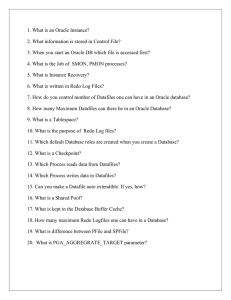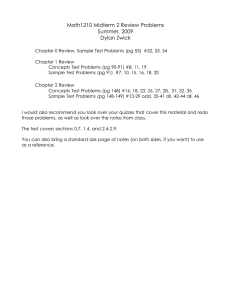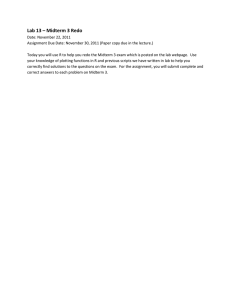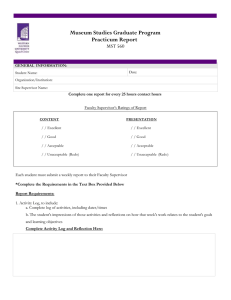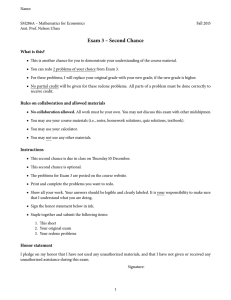Structures Used for Database Recovery
advertisement
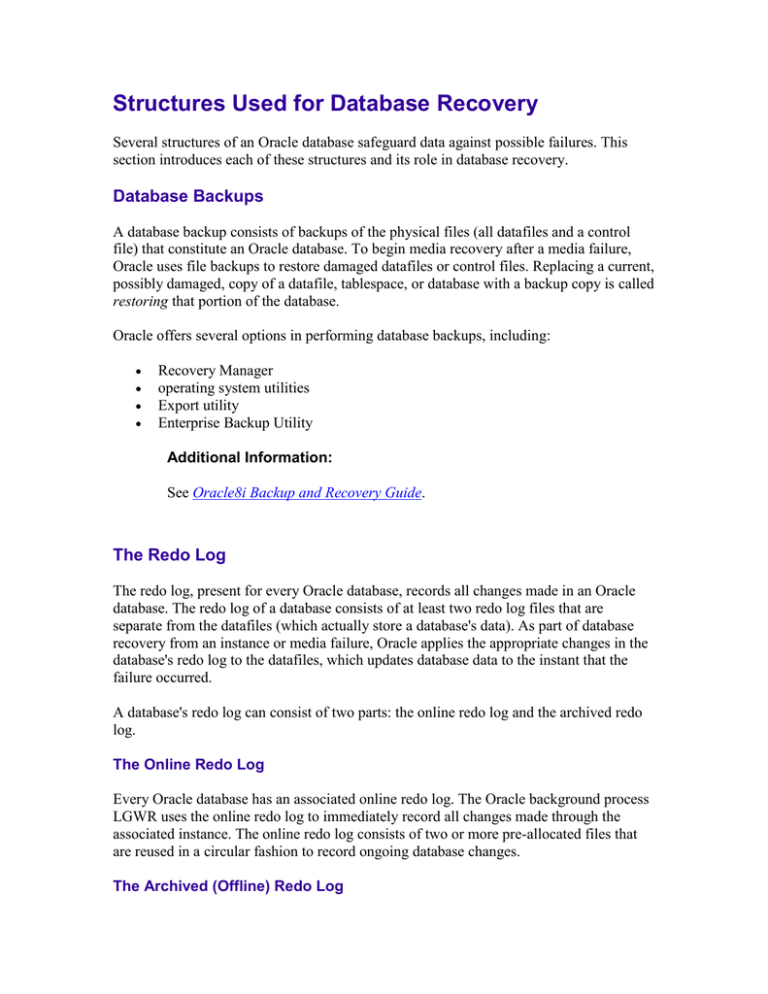
Structures Used for Database Recovery Several structures of an Oracle database safeguard data against possible failures. This section introduces each of these structures and its role in database recovery. Database Backups A database backup consists of backups of the physical files (all datafiles and a control file) that constitute an Oracle database. To begin media recovery after a media failure, Oracle uses file backups to restore damaged datafiles or control files. Replacing a current, possibly damaged, copy of a datafile, tablespace, or database with a backup copy is called restoring that portion of the database. Oracle offers several options in performing database backups, including: Recovery Manager operating system utilities Export utility Enterprise Backup Utility Additional Information: See Oracle8i Backup and Recovery Guide. The Redo Log The redo log, present for every Oracle database, records all changes made in an Oracle database. The redo log of a database consists of at least two redo log files that are separate from the datafiles (which actually store a database's data). As part of database recovery from an instance or media failure, Oracle applies the appropriate changes in the database's redo log to the datafiles, which updates database data to the instant that the failure occurred. A database's redo log can consist of two parts: the online redo log and the archived redo log. The Online Redo Log Every Oracle database has an associated online redo log. The Oracle background process LGWR uses the online redo log to immediately record all changes made through the associated instance. The online redo log consists of two or more pre-allocated files that are reused in a circular fashion to record ongoing database changes. The Archived (Offline) Redo Log Optionally, you can configure an Oracle database to archive files of the online redo log once they fill. The online redo log files that are archived are uniquely identified and make up the archived redo log. By archiving filled online redo log files, older redo log information is preserved for operations such as media recovery, while the pre-allocated online redo log files continue to be reused to store the most current database changes. Datafiles that were restored from backup, or were not closed by a clean database shutdown, may not be completely up to date. These datafiles must be updated by applying the changes in the archived and/or online redo logs. This process is called recovery. See "Database Archiving Modes" for more information. Rollback Segments Rollback segments are used for a number of functions in the operation of an Oracle database. In general, the rollback segments of a database store the old values of data changed by ongoing transactions (that is, uncommitted transactions). Among other things, the information in a rollback segment is used during database recovery to "undo" any "uncommitted" changes applied from the redo log to the datafiles. Therefore, if database recovery is necessary, the data is in a consistent state after the rollback segments are used to remove all uncommitted data from the datafiles. Control Files In general, the control file(s) of a database store the status of the physical structure of the database. Certain status information in the control file (for example, the current online redo log file, the names of the datafiles, and so on) guides Oracle during instance or media recovery. See "Control Files" for more information. Rolling Forward and Rolling Back Database buffers in the buffer cache in the SGA are written to disk only when necessary, using a least-recently-used algorithm. Because of the way that the DBWn process uses this algorithm to write database buffers to datafiles, datafiles might contain some data blocks modified by uncommitted transactions and some data blocks missing changes from committed transactions. Two potential problems can result if an instance failure occurs: Data blocks modified by a transaction might not be written to the datafiles at commit time and might only appear in the redo log. Therefore, the redo log contains changes that must be reapplied to the database during recovery. After the roll forward phase, the datafiles may contain changes that had not been committed at the time of the failure. These uncommitted changes must be rolled back to ensure transactional consistency. These changes were either saved to the datafiles before the failure, or introduced during the roll forward phase. To solve this dilemma, two separate steps are generally used by Oracle for a successful recovery of a system failure: rolling forward with the redo log (cache recovery) and rolling back with the rollback segments (transaction recovery). The Redo Log and Rolling Forward The redo log is a set of operating system files that record all changes made to any database buffer, including data, index, and rollback segments, whether the changes are committed or uncommitted. Each redo entry is a group of change vectors describing a single atomic change to the database. The redo log protects changes made to database buffers in memory that have not been written to the datafiles. The first step of recovery from an instance or disk failure is to roll forward, or reapply all of the changes recorded in the redo log to the datafiles. Because rollback data is also recorded in the redo log, rolling forward also regenerates the corresponding rollback segments. This is called cache recovery. Rolling forward proceeds through as many redo log files as necessary to bring the database forward in time. Rolling forward usually includes online redo log files and may include archived redo log files. After roll forward, the data blocks contain all committed changes. They may also contain uncommitted changes that were either saved to the datafiles before the failure, or were recorded in the redo log and introduced during roll forward. Rollback Segments and Rolling Back Rollback segments record database actions that should be undone during certain database operations. In database recovery, rollback segments undo the effects of uncommitted transactions previously applied by the rolling forward phase. After the roll forward, any changes that were not committed must be undone. After redo log files have reapplied all changes made to the database, then the corresponding rollback segments are used. Rollback segments are used to identify and undo transactions that were never committed, yet were either saved to the datafiles before the failure, or were applied to the database during the roll forward. This process is called rolling back or transaction recovery. Figure 32-1 illustrates rolling forward and rolling back, the two steps necessary to recover from any type of system failure. Figure 32-1 Basic Recovery Steps: Rolling Forward and Rolling Back Oracle can roll back multiple transactions simultaneously as needed. All transactions system-wide that were active at the time of failure are marked as DEAD. Instead of waiting for SMON to roll back dead transactions, new transactions can recover blocking transactions themselves to get the row locks they need. Improving Recovery Performance When a database failure occurs, rapid recovery is very important in most situations. Oracle provides a number of methods to make recovery as quick as possible, including: Parallel Recovery Fast-Start Recovery Transparent Application Failover Performing Recovery in Parallel Recovery reapplies the changes generated by several concurrent processes, and therefore instance or media recovery can take longer than the time it took to initially generate the changes to a database. With serial recovery, a single process applies the changes in the redo log files sequentially. Using parallel recovery, several processes simultaneously apply changes from redo log files. Attention: Oracle8i provides limited parallelism with Recovery Manager; the Oracle8i Enterprise Edition allows unlimited parallelism. See Getting to Know Oracle8i for more information about the features available in Oracle8i and Oracle8i Enterprise Edition. Parallel recovery can be performed using three methods: Parallel recovery can be performed manually by spawning several Oracle Enterprise Manager sessions and issuing the RECOVER DATAFILE command on a different set of datafiles in each session. However, this method causes each Oracle Enterprise Manager session to read the entire redo log file. You can use the Recovery Manager's RESTORE and RECOVER commands to automatically parallelize all stages of recovery. Oracle uses one process to read the log files sequentially and dispatch redo information to several recovery processes, which apply the changes from the log files to the datafiles. The recovery processes are started automatically by Oracle, so there is no need to use more than one session to perform recovery. There are also some initialization parameters to set for automatic parallel recovery. Refer to the Oracle8i Parallel Server Setup and Configuration Guide for details. You can use the SQL*Plus RECOVER command to perform parallel recovery. Refer to the SQL*Plus User's Guide and Reference for details. You can use the SQL command ALTER DATABASE RECOVER to perform parallel recovery but this is not recommended. Situations That Benefit from Parallel Recovery In general, parallel recovery is most effective at reducing recovery time when several datafiles on several different disks are being recovered concurrently. Crash recovery (recovery after instance failure) and media recovery of many datafiles on many different disk drives are good candidates for parallel recovery. The performance improvement from parallel recovery is also dependent upon whether the operating system supports asynchronous I/O. If asynchronous I/O is not supported, parallel recovery can dramatically reduce recovery time. If asynchronous I/O is supported, the recovery time may only be slightly reduced by using parallel recovery. Additional Information: See your operating system documentation to determine whether the system supports asynchronous I/O. Recovery Processes In a typical parallel recovery situation, one process is responsible for reading and dispatching redo entries from the redo log files. This is the dedicated server process that begins the recovery session. The server process reading the redo log files enlists two or more recovery processes to apply the changes from the redo entries to the datafiles. Figure 32-2 illustrates a typical parallel recovery session. Figure 32-2 Typical Parallel Recovery Session In most situations, one recovery session and one or two recovery processes per disk drive containing datafiles needing recovery is sufficient. Recovery is a disk-intensive activity as opposed to a CPU-intensive activity, and therefore the number of recovery processes needed is dependent entirely upon how many disk drives are involved in recovery. In general, a minimum of eight recovery processes is needed before parallel recovery can show improvement over a serial recovery. Fast-Start Recovery Fast-Start Recovery is an architecture that reduces the time required for rolling forward and makes the recovery bounded and predictable. It also eliminates rollback time from recovery for transactions aborted due to system faults. Fast-Start Recovery includes: Fast-Start Checkpointing Fast-Start On-Demand Rollback Fast-Start Parallel Rollback Fast-Start Checkpointing Fast-Start Checkpointing records the position in the redo thread (log) from which crash or instance recovery would need to begin. This position is determined by the oldest dirty buffer in the buffer cache. Each DBWn process continually writes buffers to disk to advance the checkpoint position, with minimal or no overhead during normal processing. Fast-Start Checkpointing improves the performance of crash and instance recovery, but not media recovery. You can influence recovery performance for situations where there are stringent limitations on the duration of crash or instance recovery. The time required for crash or instance recovery is roughly proportional to the number of data blocks that need to be read or written during the roll forward phase. You can specify a limit, or bound, on the number of data blocks that will need to be processed during roll forward. The Oracle server automatically adjusts the checkpoint write rate to meet the specified roll-forward bound while issuing the minimum number of writes. You can set the dynamic initialization parameter FAST_START_IO_TARGET to limit the number of blocks that need to be read for crash or instance recovery. Smaller values of this parameter impose higher overhead during normal processing because more buffers have to be written. On the other hand, the smaller the value of this parameter, the better the recovery performance, since fewer blocks need to be recovered. The dynamic initialization parameters LOG_CHECKPOINT_INTERVAL and LOG_CHECKPOINT_TIMEOUT also influence Fast-Start Checkpointing. Additional Information: See Oracle8i Tuning for information about how to set the value of FAST_START_IO_TARGET, and see Oracle8i Backup and Recovery Guide for a detailed description of checkpoints. Fast-Start On-Demand Rollback When a dead transaction holds a row lock on a row that another transaction needs, FastStart On-Demand Rollback immediately recovers only the data block under consideration, leaving the rest of the dead transaction to be recovered in the background. This improves the availability of the database for users accessing data that is locked by large dead transactions. If Fast-Start Rollback is not enabled, the user would have to wait until the entire dead transaction was recovered before obtaining the row lock. Fast-Start Parallel Rollback Fast-Start Parallel Rollback allows a set of transactions to be recovered in parallel using a group of server processes. This technique is used when SMON determines that the amount of work it takes to perform recovery in parallel is less than the time it takes to recovery serially. Masking Failures with Transparent Application Failover Rapid recovery minimizes the time data is unavailable to users, but it does not address the disruption caused when user sessions fail. Users need to re-establish connections to the database, and work in progress may be lost. Oracle8i Transparent Application Failover (TAF) can mask many failures from users, preserving the state of their applications and resuming queries that had been in progress at the time of the failure. Developers can further extend these capabilities by building applications that leverage TAF and make all failures, including those affecting transactions, transparent to users. Additional Information: See the Oracle8i Tuning for more information about Transparent Application Failover. Recovery Manager Recovery Manager is a utility that manages the processes of creating backups of all database files (datafiles, control files, and archived redo log files) and restoring or recovering files from backups. Additional Information: See the Oracle8i Backup and Recovery Guide for a full description of Recovery Manager. Recovery Catalog Recovery Manager maintains a repository called the recovery catalog, which contains information about backup files and archived log files. Recovery Manager uses the recovery catalog to automate both restore operations and media recovery. The recovery catalog contains: information about backups of datafiles and archive logs information about datafile copies information about archived redo logs and copies of them information about the physical schema of the target database named sequences of commands called stored scripts. The recovery catalog is maintained solely by Recovery Manager. The database server of the backed-up database never accesses the recovery catalog directly. Recovery Manager propagates information about backup datafile sets, archived redo logs, backup control files, and datafile copies into the recovery catalog for long-term retention. When doing a restore, Recovery Manager extracts the appropriate information from the recovery catalog and passes it to the database server. The server performs various integrity checks on the input files specified for a restore. Incorrect behavior by Recovery Manager cannot corrupt the database. The Recovery Catalog Database The recovery catalog is stored in an Oracle database. It is the database administrator's responsibility to make such a database available to Recovery Manager. Taking backups of the recovery catalog is also the database administrator's responsibility. Since the recovery catalog is stored in an Oracle database, you can use Recovery Manager to back it up. If the recovery catalog is destroyed and no backups are available, then it can be partially reconstructed from the current control file or control file backups. Operation Without a Recovery Catalog Use of a recovery catalog is not required, but is recommended. Since most information in the recovery catalog is also available from the control file, Recovery Manager supports an operational mode where it uses only the control file. This operational mode is appropriate for small databases where installation and administration of another database to serve as the recovery catalog would be burdensome. Some Recovery Manager features are only available when a recovery catalog is used. Additional Information: See the Oracle8i Backup and Recovery Guide for information about creating the recovery catalog, and about which Recovery Manager features require use of a recovery catalog. Parallelization Recovery Manager can parallelize its operations, establishing multiple logon sessions and conducting multiple operations in parallel by using non-blocking UPI. Concurrent operations must operate on disjoint sets of datafiles. Attention: The Oracle8i Enterprise Edition allows unlimited parallelism. Oracle8i can only allocate one Recovery Manager channel at a time, thus limiting the parallelism to one stream. See Getting to Know Oracle8i for more information about the features available with Oracle8i and Oracle8i Enterprise Edition. Parallelization of the backup, copy, and restore commands is handled internally by the Recovery Manager. You only need to specify: a list of one or more sequential I/O devices the objects to be backed up, copied, or restored. Recovery Manager executes commands serially, that is, it completes the previous command before starting the next command. Parallelism is exploited only within the context of a single command. Thus, if 10 datafile copies are desired, it is better to issue a single copy command that specifies all 10 copies rather than 10 separate copy commands. Report Generation The report and list commands provide information about backups and image copies. The output from these commands is written to the message log file. The report command produces reports that can answer questions such as: what files need a backup? what files haven't had a backup in a while? what backup files can be deleted? You can use the report need backup and report unrecoverable commands on a regular basis to ensure that the necessary backups are available to perform recovery, and that the recovery can be performed within a reasonable length of time. The report deletable command lists backup sets and datafile copies that can be deleted either because they are redundant or because they could never be used by a recover command. A datafile is considered unrecoverable if an unlogged operation has been performed against a schema object residing in the datafile. (A datafile that does not have a backup is not considered unrecoverable. Such datafiles can be recovered through the use of the create datafile command, provided that logs starting from when the file was created still exist.) The list command queries the recovery catalog and produces a listing of its contents. You can use it to find out what backups or copies are available: backups or copies of a specified list of datafiles backups or copies of any datafile that is a member of a specified list of tablespaces backups or copies of any archive logs with a specified name and/or within a specified range incarnations of a specified database.
